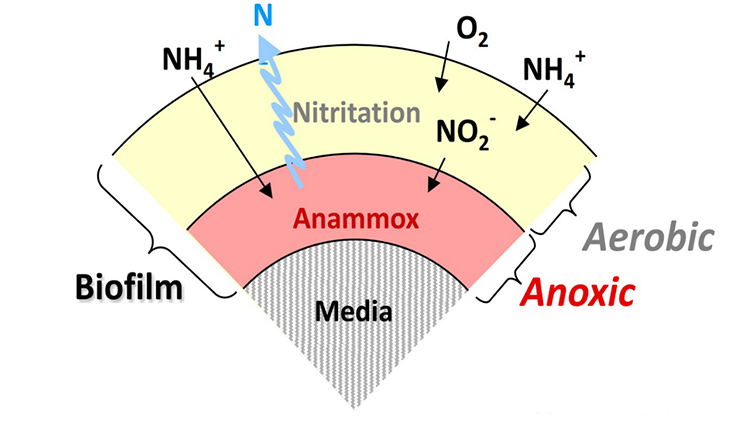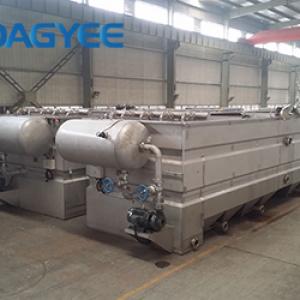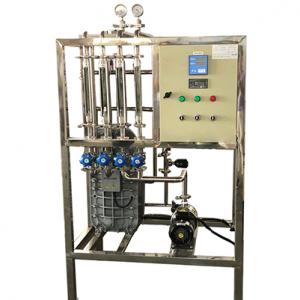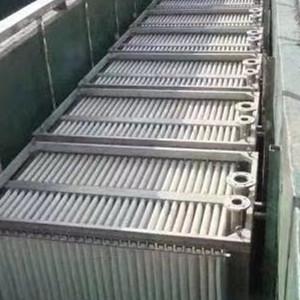Analysis of Factors Affecting Film Formation of MBBR Biological Filler
The MBBR process has been widely used as a mature process in rural domestic sewage, papermaking wastewater, food industry wastewater, slaughter wastewater, oil refining wastewater and other industrial wastewater. It can also treat urban domestic wastewater and mixed wastewater of urban wastewater and industrial wastewater.
1. The influence of dissolved oxygen (DO) on the MBBR method
In the simultaneous nitrification-denitrification biological denitrification process in MBBR, DO concentration is a major limiting factor affecting simultaneous nitrification-denitrification. By controlling the concentration of DO, different parts of the biofilm can be formed into aerobic or hypoxic zones, so that physical conditions for simultaneous nitrification and denitrification can be achieved. Theoretically speaking, when the DO mass concentration is too high, DO can penetrate into the biofilm, making it difficult to form anoxic zone inside, and a large amount of ammonia nitrogen is oxidized into nitrate and nitrite, making the TN of the effluent still high ; Conversely, if the DO concentration is very low, a large proportion of the anaerobic zone inside the biofilm will be created, and the biofilm denitrification capacity will be enhanced (the effluent nitrate and nitrite nitrogen concentrations are very low), but due to insufficient DO supply, MBBR The nitrification effect of the process decreases, which increases the ammonia nitrogen concentration of the effluent, which causes the TN of the effluent to rise, which affects the final treatment effect.
The best value of DO for the treatment of municipal sewage by MBBR: when the mass concentration of DO is above 2mg/L, DO has little effect on the nitrification effect of MBBR, the removal rate of ammonia nitrogen can reach 97%-99%, and the ammonia nitrogen in the effluent can be Keep it below 1.0mg/L; when the DO mass concentration is around 1.0mg/L, the removal rate of ammonia nitrogen will be around 84%, and the ammonia nitrogen concentration of the effluent will increase significantly. In addition, the DO in the aeration tank should not be too high, too high dissolved oxygen can cause the organic pollutants to decompose too fast, which makes the microorganisms lack of nutrients, the activated sludge is prone to aging, and the structure is loose. In addition, too high DO and excessive energy consumption are economically unsuitable.
Because the MBBR method mainly uses suspended fillers to achieve the final sewage treatment, the effect of DO on suspended fillers is also the key to the overall treatment results. Under the action of aeration, the water fluidizes with the fillers, and the turbulence of the water flow is greater than that without fillers, which accelerates the renewal of the gas-liquid interface and the transfer of oxygen, and increases the rate of oxygen transfer. With the increase in the number of fillers, the cutting and turbulent effects between the fillers, airflow and water flow continue to strengthen. When the filling rate of the filler reaches 60%, the fluidization effect of the filler in the water becomes worse, and the degree of turbulence of the water body also decreases, so that the oxygen transmission rate decreases and the oxygen utilization rate decreases. Therefore, for different types of water quality, controlling the amount of DO is crucial to the final treatment result of the entire process.
2. The influence of hydraulic retention time on MBBR process
The proper hydraulic retention time (HRT) is an important control factor to ensure the purification effect and the economics of project investment. The length of hydraulic retention time will directly affect the contact time of organic matter in water and biofilm, and then affect the adsorption and degradation efficiency of microorganisms on organic matter. Therefore, finding an economical and reasonable HRT for different sewage types is one of the key issues. Research on HRT at home and abroad is not limited to studying the impact of HRT itself, but to grasp the macroscopically through experiments.
3. The influence of water temperature on MBBR method
Among the factors that affect the physiological activities of microorganisms, the role of temperature is very important. Suitable temperature can promote and strengthen the physiological activities of microorganisms; inappropriate temperature can weaken or even destroy the physiological activities of microorganisms. Unsuitable temperature can also cause changes in the morphology and physiological characteristics of microorganisms, and may even kill microorganisms. The optimal temperature of microorganisms means that under this temperature condition, the physiological activities of microorganisms are strong and vigorous. In terms of proliferation, the fission rate is fast and the generation time is short. The MBBR method mainly achieves the degradation of organic pollutants in sewage through the metabolism of various types of microorganisms in the biofilm, so the growth of the biofilm will directly affect the final result of wastewater treatment, especially for nitrifying bacteria and denitrifying bacteria In other words, they have a long growth cycle and are very sensitive to environmental changes. The suitable temperature for nitrifying bacteria is 20℃-30℃, and the suitable temperature for denitrifying bacteria is 20℃-40℃. When the temperature is lower than 15℃, this The activity of the two types of bacteria is reduced, 5~C is completely stopped, so the change of temperature will directly affect the growth of these bacteria.
4. The influence of pH on MBBR method
The physiological activities of microorganisms are closely related to the pH of the environment. Only under suitable pH conditions can microorganisms carry out normal physiological activities. If the pH value is too large and deviates from the appropriate value, the catalytic function of the enzyme system of the microorganism will be weakened or even disappear. The pH values adapted to the physiological activities of different species of microorganisms have a certain range. Within this range, it can be divided into the lowest pH value, the optimal pH value and the highest pH value. In the lowest or highest pH environment, although microorganisms can survive, their physiological activities are weak, they are prone to death, and their proliferation rate is greatly reduced. Microorganisms involved in biological sewage treatment generally have the best pH range between 6.5-8.5. The MBBR method, as a process combining biofilm method and activated sludge method, also relies on the growth of microorganisms to achieve the purpose of organic matter degradation. Therefore, maintaining the optimal pH range of microorganisms is a necessary condition for good sewage treatment effects. When the pH value of sewage (especially industrial wastewater) changes greatly, it is necessary to consider setting up an adjustment tank to adjust the pH value of the sewage to an appropriate range. Perform aeration.





